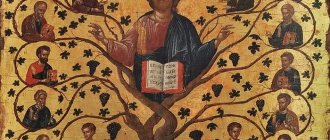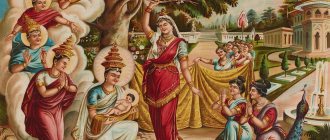What do you imagine when you hear the word “sect”?
Someone will have an image of occult rituals in a circle of candles. Another will call any religion where there is no Jesus Christ a sect.
So Protestantism causes a lot of controversy and questions among believers. It is often said that there are Protestant sects. But in general, are Protestants sectarians or not?
Let us present the Orthodox point of view. Keep in mind that other denominations of Christianity may have their own views.
On October 31, 1517, Martin Luther published 95 theses, which gave rise to Protestantism; he opposed the new movement to sects
Who are Protestants and why are they considered sectarians?
I believe in God, but my church is a Protestant church.
Sometimes some people don’t understand what the actual difference is, which is why I’m writing a large detailed article with facts, history and figures, where I try to explain everything. By the way, the word PROTESTANTISM does not come from the word PROTEST. It's just a coincidence in the Russian language. Protestantism or Protestantism (from Latin protestans, gen. protestantis - publicly proving).
According to supporters of the Reformation, the Roman Catholic Church departed from the original Christian principles as a result of numerous layers of medieval theology and ritual.
Who are considered Protestants?
Protestantism, having emerged as a combination of different movements, was never united. Its largest movements include Lutheranism, Calvinism and Anglicanism, which are commonly called “classical” Protestantism or the first wave of the Reformation. Other independent denominations that arose in the 17th-19th centuries are associated with them. (second wave of the Reformation), which differ from each other in dogma, cult and organization: Baptists, Quakers, Mennonites, Methodists, Adventists, etc. Pentecostalism, which appeared in the twentieth century, is classified as the third wave of the Reformation.
Protestants from a theological point of view
There is a lot to be said here. And we need to start with what Protestants consider the basis of their faith. This is, first of all, the Bible - the Books of Holy Scripture. It is the infallible written Word of God. It is uniquely, verbally and completely, inspired by the Holy Spirit and unerringly recorded in the original manuscripts. The Bible is the highest and final authority on all matters it deals with.
In addition to the Bible, Protestants recognize the creeds generally accepted by all Christians:
Protestant theology does not contradict the theological decisions of the Ecumenical Councils.
The whole world knows the famous five theses of Protestantism:
1. Sola Scriptura - “Only Scripture”
“We believe, teach and confess that the only and absolute rule and standard by which all doctrines and all teachers are to be judged are the prophetic and apostolic Scriptures of the Old and New Testaments.”
2. Sola fide - “Only by faith”
This is the doctrine of justification by faith alone, regardless of the performance of good works and any external sacred rites. Protestants do not devalue good deeds; but they deny their significance as the source or condition of the salvation of the soul, considering them the inevitable fruits of faith and evidence of forgiveness.
3. Sola gratia - “Only by grace”
This is the doctrine that salvation is grace, i.e. a good gift from God to man. A person cannot earn salvation or somehow participate in his own salvation. Although a person accepts God's salvation by faith, all the glory for a person's salvation should be given to God alone.
The Bible says, “For by grace you have been saved, through faith; and this not of yourselves, it is the gift of God; not by works, so that no one can boast” (Eph. 2:8,9).
4. Solus Christus - “Only Christ”
From the point of view of Protestants, Christ is the only mediator between God and man, and salvation is possible only through faith in Him.
Scripture states: “For there is one God, and one mediator between God and men, the man Christ Jesus” (1 Tim. 2:5). Protestants traditionally deny the mediation of the Virgin Mary and other saints in the matter of salvation, and also teach that the church hierarchy cannot be a mediator between God and people. All believers constitute the “universal priesthood” and have equal rights and standing before God.
5. Soli Deo gloria - “Only God be the glory”
This is the doctrine that man should honor and worship God alone, since salvation is bestowed only and only through His will and actions. No man has the right to equal glory and honor with God.
Original sin distorted human nature. Therefore, a person, although he remains fully capable of good deeds, cannot be saved by his own merits, but only by faith in the atoning sacrifice of Jesus Christ.”
Today in the Russian Federation there are about 3 million Protestants of various directions.
And here is what Sergei Kiriyenko, first deputy head of the presidential administration of the Russian Federation, said:
The Protestant community in Russia “plays a big role”
in social service, helping people in difficult life situations, regardless of their religious affiliation
And finally, an important document signed by Russian President Vladimir Putin, dedicated to the celebration of the 500th anniversary of the Reformation.
Many people indeed consider Protestants to be sectarians, but this is due to ignorance and ignorance. The doctrines are the same, the Bible is the same, the faith is the same, God is the same.
What do you think, is there a difference for you? Or is this not what determines a person’s true faith?
Source
Protestants have a simplified liturgical practice
Protestants try to follow simplicity and practicality in everything. Candles are used very rarely during services. For example, Lutherans and Anglicans have them. There are crosses near these same directions.
The decor is strictly maintained: no flowers, gilding, icons, etc. With rare exceptions. All this is considered unnecessary attributes.
Servants usually prefer regular business attire: tie, shirt, jacket, etc. This has its own meaning: Jesus Christ did not wear any magnificent church attire, and neither did the apostles. This means that the clergyman does not need them either.
The service rooms have benches, perhaps a podium for the speaker, and a microphone. Protestants consider this sufficient, because faith is not within walls.
Cathedral of the Holy Apostles Peter and Paul - the building of the Lutheran Church
Since the Protestant church is unpretentious in choosing premises, they often simply rent some buildings or halls.
But these are not mandatory conditions and it happens differently.
For example, the Cathedral of the Holy Apostles Peter and Paul looks like a luxurious building in the tradition of temple architecture.
It was founded in 1905 by the Lutheran Church. Architect V. A. Kossov.
1905
this year the Lutheran Cathedral of the Holy Apostles Peter and Paul was founded
This Protestant cathedral has a complex of buildings and an organ. However, inside there are white walls and benches, traditional for Protestantism.
How did Protestantism originate?
The origin of Protestantism is inextricably linked with the Reformation. This is the name of the movement that arose in the 16th century in the Catholic Church in Germany. The leader of the Reformation was Martin Luther, a Catholic monk, thanks to his studies at the University of Wittenberg, he had extensive knowledge in the field of theology and other sciences. It is believed that Luther took the monastic vow after being caught in a heavy rain and thunderstorm in a field. Falling to the ground, he prayed for salvation and promised to dedicate his life to God if he survived. Being a zealot of faith, young Luther was shocked by the free morals that reigned in Rome in 1511.
In the churches, indulgences were sold, and often fake shrines were worshiped, such as the “thorn from the Savior’s crown of thorns.” All this cost a lot of money. The priests behaved dissolutely, and the flock did not understand half of what was happening at the service. Returning from Rome, the amazed Martin Luther decided to take up the challenge of changing the established order in the Catholic Church. He did not think about creating a new denomination, but wanted to reform the old one, believing that due to the accumulation of rituals, the Church had moved away from its true purpose and from the word of the Savior.
Thinking for a long time about how to correct the current situation, on October 31, 1517, Luther, according to a widespread legend, nailed 95 theses to the door of the Wittenberg Church, in which he outlined the principles of the Reformation. Luther criticized the dogma of Purgatory and demanded that indulgences be abolished and that the laity be allowed to read Scripture in German. One of the works of his whole life was the translation of the Bible into German. In those days, only those who knew Latin were able to read Scripture.
While Luther retired to translate Scripture, pogroms of Catholic churches began in the country. Upon learning of this, Martin Luther came out to announce that he wanted something completely different. His wife was Katharina von Bora, a runaway nun (Luther rejected the idea of monasteries; in his opinion, Christ and the apostles did not leave the world). During Luther's trial, he was asked to abandon the principles of Protestantism. Without thinking twice, Martin Luther declared “I stand on this and cannot do otherwise, so help me God!” His sentence was not harsh. But the Catholic Church did not accept the reforms. Luther by that time had thousands of followers. The result was the emergence of a new confession - Protestantism.
Protestantism is not a sect, but a direction of Christianity
Protestantism does not meet the characteristics of a sect. This is a branch of Christianity and an independent religious tradition. If a sect is formed under the influence of heretical ideas, then Protestant churches are the result of a church schism.
The schism does not at all depend on theological differences, although it does not exclude them. It is caused by many reasons, their combination, including administrative, political, national, etc.
Worship in the Evangelical Church - one of the many directions of Protestantism
It is not surprising that under the influence of time, the cultural environment, and church leaders, each church branch develops its own characteristics.
But this does not negate the main thing: the breakaway, in our case the Protestant church, is not a sect. There are enough reasons to say this:
- Protestantism has a chain of succession from the apostles. The tradition of ordaining priests has been preserved in a number of denominations. For example, Anglicanism and Old Catholicism. Although many areas of Protestantism put conformity to the Church's Holy Scripture in the foreground, and ignore continuity through ordination. For Protestants, fidelity to serving biblical principles is the main sign of the continuity of the teachings of the apostles.
- Other faiths perceive Protestantism as an independent branch of Christianity.
- States all over the world recognize Protestantism not as a sect, but as a full-fledged religion.
Where did the name "Protestant" come from?
There are several versions of the answer to this question. The main version is historical. In 1526, the First Speyer Reichstag, at the request of the German Lutheran princes, suspended the Edict of Worms against Martin Luther. However, the 2nd Reichstag of Speyer in 1529 overturned this decree. In response to this, the so-called “Speyer protest” was submitted to the Reichstag in Germany by six princes and fourteen free cities of the Holy Roman Empire. Based on the title of this document, supporters of the Reformation were subsequently called “Protestants,” and the denominations that emerged as a result of the Reformation were called “Protestant.”
To become a Protestant, you need to study this tradition and be baptized
How do you become Protestant? This is a conscious choice of a person.
The core of Protestantism is the idea of conscious acceptance of religion.
Therefore, there are very few areas of this tradition in which a person is baptized from birth. Although there are some.
One has to go a long way and study well the ideas of the Protestant Church. It is important that a person really understands what a Christian’s worldview is and how, in fact, this church differs from others. Sometimes you need to take an exam, for example, answer catachesis questions.
When the decision is consciously made, the person is baptized.
Most often among Protestants, the ritual is symbolic, although much depends on the specific tradition. After this, a person can consider himself a Protestant and continue to live by faith. It is recommended that you study the Bible carefully.
The ritual side is not so important for Protestantism. It does not contain the idea of visiting a temple and praying to icons. Home prayer is a more common practice.
If an Orthodox person wants to become a Protestant, then the question of rebaptism arises. It is solved in different ways. If an Orthodox Christian is baptized at an unconscious age, then most often he is recommended to be baptized into Protestantism.
Protestant baptism. Baptistism
But this is not interpreted as rebaptism, but as the first conscious baptism. What happened in childhood is not considered a properly performed sacrament.
If an Orthodox believer is baptized at a conscious age, then he may not be rebaptized. The idea is popular among Protestants that baptism in Orthodoxy or Catholicism is identical to any other.
A person has already joined the Church of Christ, and the choice of tradition does not change this fact.
Sectarian trends in the Protestant Church
Perhaps every church has its own sects, Protestantism is no exception.
- Baptistism.
The sect appeared in the 17th century. The main difference from, for example, Lutheranism is that Baptists are baptized as adults and before that they must undergo a one-year probationary period (the rite of catechism). Baptists do not recognize objects of worship, but adhere to the sacraments. Now the Baptist Church is not considered sectarian. - 7th Day Adventists.
In the 19th century, a sect appeared in the United States whose main goal was to await the Second Coming. The founder of this sect was farmer William Miller, who, through mathematical calculations, predicted the end of the world and the Second Coming in 1844. As we know, this did not happen, but Adventists continue to believe, citing mainly the Old Testament. - Pentecostals.
Again, the movement arose in the USA, but it is younger - it appeared in the middle of the 20th century. The goal of Pentecostals is to revive the gifts of the Holy Spirit that the apostles received on the day of Pentecost. The focus is on the ability to speak different languages. There have been cases in Pentecostal history where people suddenly began speaking in foreign tongues. Followers of this church recognize some sacraments, original sin, and the Holy Trinity.










